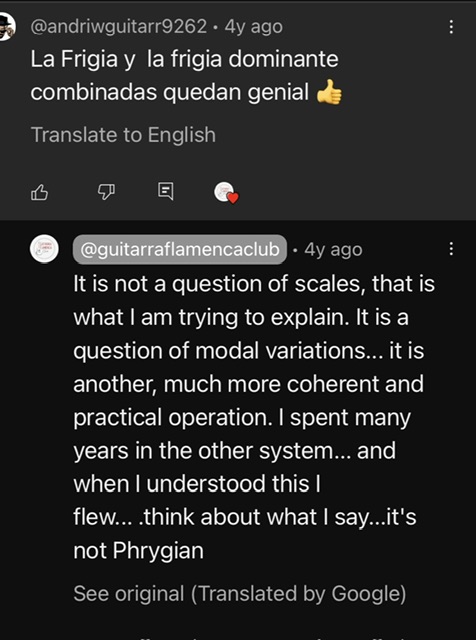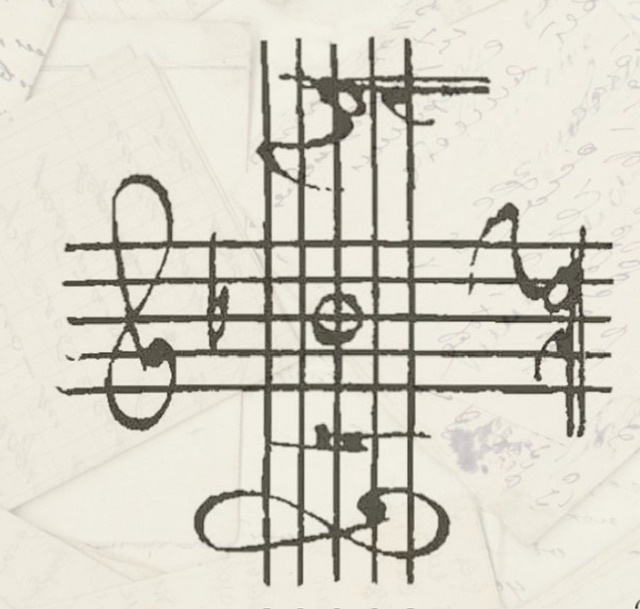|
Ricardo -> RE: Basic theory question (Oct. 17 2024 13:38:09)
|
quote:
To make sure I understood correctly, can you sum up what he said about Manolo Sanlucar's flamenco mode at 10:30-14:10?
Any reason why C# (or generally speaking major 6th interval from the tonic) is not included in E flamenco mode?
The guy in the video (which is as old as your thread, at least while it was running it is that old, 2020, ie, not NEW info since those days), is trying, in vain to point out flamenco is NOT about scales at all. I say in vain because he has to reiterate in the comment section several times, meaning he was not crystal clear (see attached comments). He calls it “modal variations”, or “flamenco mode variations”, but what he means, and refers to Manolo’s book, which I can say I have finally read through, is that flamenco is not based on scales, but like I used to say over and freaking over, it is a KEY CENTER. The issue Manolo had – and many people don’t seem to understand because they have very little schooling– is that the main stream common practice period theory only uses TWO key centers (major and minor), and our flamenco appears to be using a THIRD KEY center, we call “flamenco mode”, and other people outside the tradition “wrongly” call “Phrygian mode”. This “flamenco mode/key” uses all chromatics, of which this guy only demos a few in context. The C# he skips is NOT DELIBERATE, it is an oversight on his part, leading to more confusion yet again. That note is the “Manuel de Falla” note every flamenco artist loves to use in context. Should have been D# in his Taranta example, had he used it.
For Manolo and others (if you read his book), the issue is that Phrygian implies a lot of baggage, and they evoke two “dirty words”:
1.ecclesiastical, and 2. Occidental.
The irony is that they (Manolo and other intellectual flamenco artists that have observed a problem nobody else seems to care about nor understand)
are CORRECT for pointing out this issue
(Manolo spends like 80% of his book ranting and raving about these horrible “schools” of thought, and how the Phrygian Dominant from the Relative minor is NOT what is going on in flamenco music),
however HAVE NOT YET PROPERLY UNDERSTOOD THE OCCIDENTAL AND ECCLESIASTICAL MUSICAL SCHOOLS THEMSELVES. They tend to think this is like some singular mentality and concept and teaching school of thought. “It” is NOT. However, hidden in that universe are some SIMPLE explanations, had they gone down the rabbit hole as I did, that would put their minds at ease. Since “occidental” and “ecclesiastical” are evil ignorant schools of thought in light of “flamenco” traditions, most will NOT be going down any such rabbit holes. I admit I myself NEVER would have either if not for some of these ANNOYING circular arguments about scales and harmony.
Long story short….the common practice period music theory begins at the Baroque and DOES NOT COMMUNICATE with the universe of the Renaissance music from which forth it was derived. Hence, nobody seems to notice that “flamenco”, which means “Flemish” as in Josquin de Prez and friends from early 16th century, had a system of MELODY and HARMONY called “Franco-Flemish polyphony” such that our beloved “flamenco mode cadence” was in full function and usage as “tercer tono” and “quarta tono” respectively. 3rd mode and 4th mode. Aka Phrygian and hypophrygian, distinguished by the TESSITURA of the main melody (cante range of notes, if you will, por arriba vs por medio) which ALWAYS descended AGFE (or DCBbA), however the harmony of other voices created “clausulae” or cadences as per sung texts, as seen in the Vihuela intabulations, etc., and still being done on GUITAR for these types of melodies today. Because the language used to describe this music uses solmization, clausulae, 4th tono, ficta, etc., there is a DISCONNECT talking about chords and such for these modes. In the common practice era, these two “church” modes collapsed into the DOMINANT of the “minor key”, forever lost as strong tonic identities they once had, and so nobody is willing to talk about any connections there. Romerito and I arguing about chords vs vertical sonorities is showing the LITERAL Mental barrier constructed there, in full force.
Flamenco in Andalucia is a fossile of those “Flemish motet” melodies and their cadences as realized between singer and vihuelist. The chromatic notes causing all the fuss are called “musica ficta” or fake notes (sharps and flats), the por arriba and por medio both included the Musica Vera , or real natural note music that uses Bb and B natural together as needed (Bb was not considered an “accidental” back then). The E major chord or A major chord are resulting from the Picardy third rule, and too many other rules still survive regarding the clausulae and modal sounds of the cante and guitar, but as you can see it is A LOT of exotic verbal baggage to contend with.
The Greek and Arabic etc., stuff is so far out of the box (see my video about desert camel cobra Arabian nights Persian music rant which is hilarious I posted not long ago), adding to the confusion, that I don’t really see an end to this argument about modes and scales, as long as it can be permitted to be invoked as an “ingredient” of flamenco music.

Images are resized automatically to a maximum width of 800px
|
|
|
|


